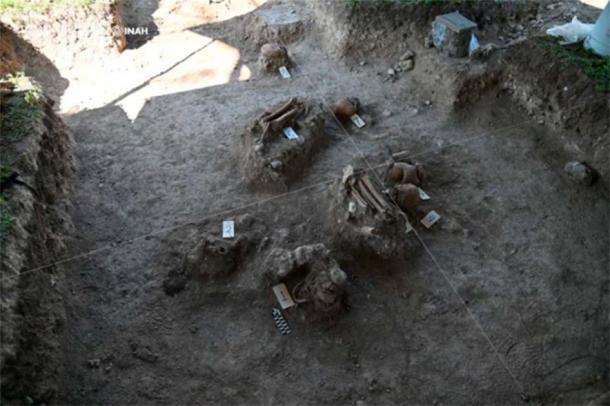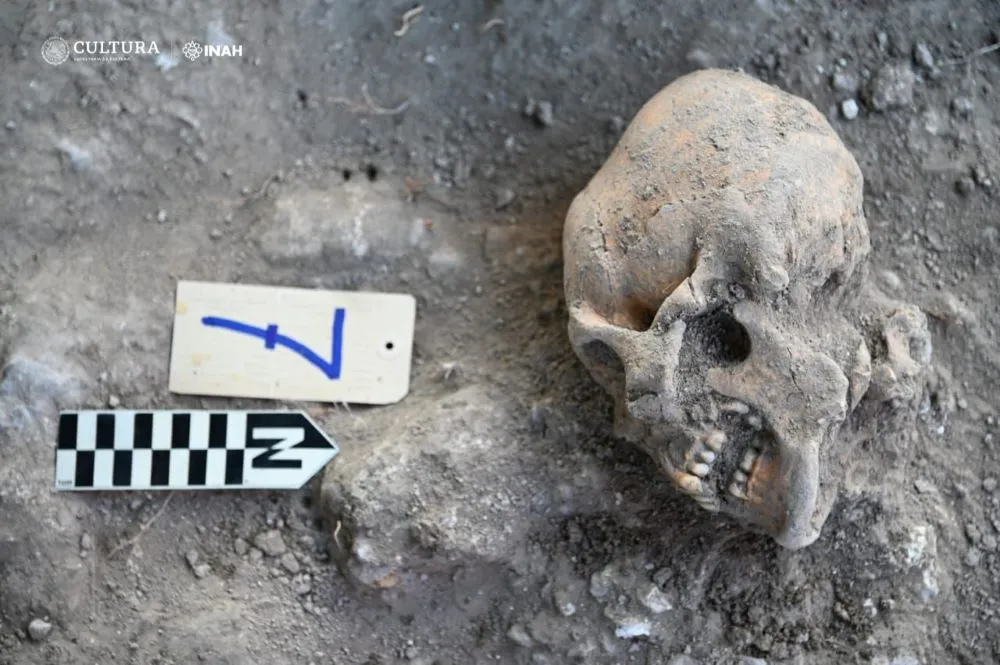Archaeologists from Mexico’s National Institute of Anthropology and History (INAH) have made a significant discovery at the Moral-Reforma Archaeological site in Balancán, Tabasco. They unearthed 13 human burials at the stairway of a temple-pyramid, with several skulls displaying marks of decapitation. Notably, eight of these individuals appear to have been young men who were decapitated as part of a ceremonial consecration of the temple, with some remains dating back as far as 2,000 years.
The decapitation marks on the skulls suggest that the victims were likely from an elevated social status, indicating their possible importance in these ritualistic ceremonies. This discovery provides crucial new insights into the relationship between temple-pyramid structures and death rituals, as well as a potential connection to a Maya underworld deity. The find highlights the complex cultural and religious practices of the ancient Maya civilization, shedding light on their beliefs and social hierarchies.
Two Groups: Deliberate Cranial Deformation

The recent discovery at the Moral-Reforma Archaeological site in Balancán, Tabasco, was part of the Moral-Reforma Archaeological Project, an initiative aimed at updating infrastructure near the Mayan Train route. This project involved excavation and consolidation work on the temple-pyramid known as Structure 18, which dates back to the Late Classic period (600-900 AD). The unearthed remains were found in two distinct groups, with the older group dating back approximately 2,000 years based on the items found alongside the burials.
The younger group of remains primarily consists of young male adults, showing signs of oblique tabular deformation, a deliberate physical alteration achieved in pre-Columbian Maya society by splinting the head during early childhood. This practice was a status symbol within the society. Additionally, dental modifications, such as filing and jade inlays, were observed in two individuals from the Late Classic period, according to the INAH press release.

Most of the skulls from this younger group were discovered deep beneath the surface, suggesting that these individuals may have been decapitated as part of a ritual. In total, 13 burials comprising male skulls, jaw fragments, and other bones were recovered. Eight individuals had been decapitated and dismembered, with their parts placed separately to consecrate the temple.
The older group of remains, detected at depths between 60 and 87 centimeters (23.5 – 34 inches), included at least 12 individuals. These burials featured a mix of primary and secondary interments, with some skeletons arranged in seated or lateral right positions at the time of death, and others brought to the site after an initial burial. This older group is linked to the Late Preclassic period (300 BC-250 AD). The associated offering included 567 items such as shell and jade beads, shell rings, projectile points, vessels, perforated shells, and bone needles.
This discovery provides invaluable insights into the funerary practices and social structures of ancient Maya society. The presence of high-status individuals and the elaborate nature of the burials underscore the cultural and religious significance of these rites, enriching our understanding of Maya civilization.
The Role of the Moral-Reforma: Strategically Located

The recent findings at the Moral-Reforma Archaeological site provide crucial evidence of the city’s significant role as a strategic enclave. This site facilitated navigation, cultural exchange, and the movement of merchandise between the Maya peoples of the Guatemalan Petén region and those on the Gulf of Mexico coast, as reported by Heritage Daily.
Founded during the Late Classic period (600-900 AD), Moral-Reforma continued to be inhabited until the Early Postclassic period (900-1200 AD). The site, spanning approximately 12 hectares, features numerous plazas, buildings, and structures that have been meticulously excavated by archaeologists.
Francisco Apolinar Cuevas Reyes, the coordinator of the research and conservation initiative, emphasized the importance of the recent discoveries. He stated that the hypothesis linking Structure 18 to death and a Maya underworld deity is supported by the peculiarities of the burials found at the site. These findings underscore the ritualistic significance of the structure within the ancient Maya culture.
The excavation and consolidation work on buildings 18 and 18SE have been completed, with ongoing work now focusing on Building 6. Researchers are in the preliminary stages of analyzing the archaeological materials, including the bone remains recovered from these structures. The careful study of these materials is expected to provide further insights into the social and cultural practices of the ancient Maya inhabitants of Moral-Reforma.
Perspective through Video
Góc nhìn qua Video
